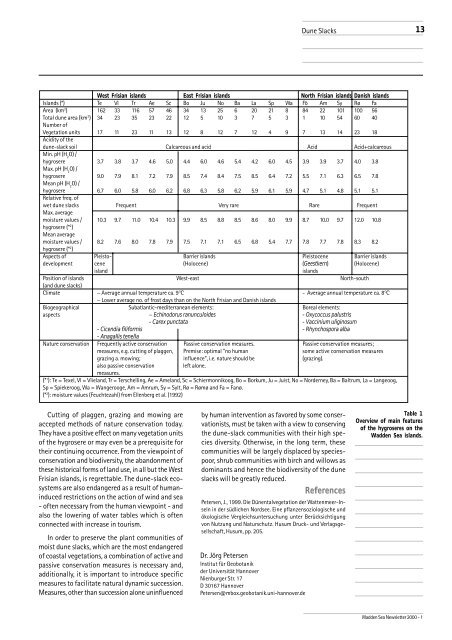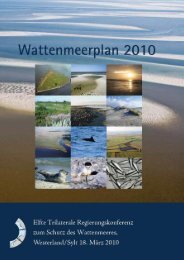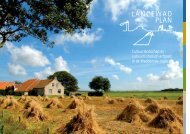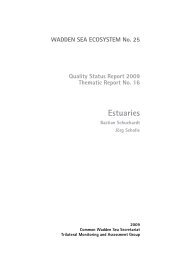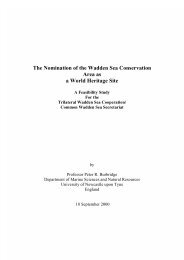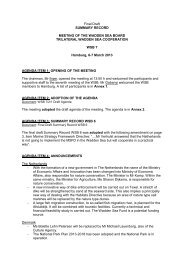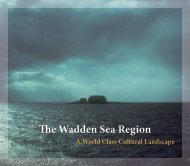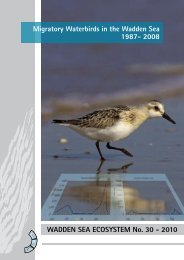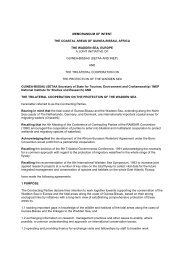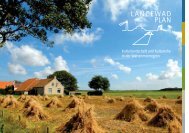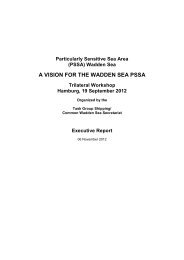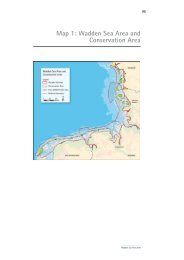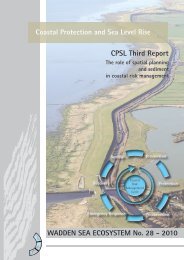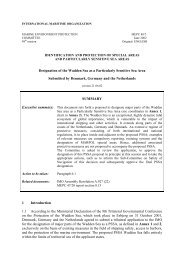Dune Slack Vegetation of the Wadden Sea Islands
Dune Slack Vegetation of the Wadden Sea Islands
Dune Slack Vegetation of the Wadden Sea Islands
You also want an ePaper? Increase the reach of your titles
YUMPU automatically turns print PDFs into web optimized ePapers that Google loves.
<strong>Dune</strong> <strong>Slack</strong>s<br />
West Frisian islands East Frisian islands North Frisian islands Danish islands<br />
<strong>Islands</strong> (*) Te Vl Tr Ae Sc Bo Ju No Ba La Sp Wa Fö Am Sy Rø Fa<br />
Area (km 2 ) 162 33 116 57 46 34 13 25 6 20 21 8 84 22 101 100 56<br />
Total dune area (km 2 ) 34 23 35 23 22 12 5 10 3 7 5 3 1 10 54 60 40<br />
Number <strong>of</strong><br />
<strong>Vegetation</strong> units 17 11 23 11 13 12 8 12 7 12 4 9 7 13 14 23 18<br />
Acidity <strong>of</strong> <strong>the</strong><br />
dune-slack soil Calcareous and acid Acid Acid+calcareous<br />
Min. pH (H 2 O) /<br />
hygrosere 3.7 3.8 3.7 4.6 5.0 4.4 6.0 4.6 5.4 4.2 6.0 4.5 3.9 3.9 3.7 4.0 3.8<br />
Max. pH (H 2 O) /<br />
hygrosere 9.0 7.9 8.1 7.2 7.9 8.5 7.4 8.4 7.5 8.5 6.4 7.2 5.5 7.1 6.3 6.5 7.8<br />
Mean pH (H 2 O) /<br />
hygrosere 6.7 6.0 5.8 6.0 6.2 6.8 6.3 5.8 6.2 5.9 6.1 5.9 4.7 5.1 4.8 5.1 5.1<br />
Relative freq. <strong>of</strong><br />
wet dune slacks Frequent Very rare Rare Frequent<br />
Max. average<br />
moisture values / 10.3 9.7 11.0 10.4 10.3 9.9 8.5 8.8 8.5 8.6 8.0 9.9 8.7 10.0 9.7 12.0 10.8<br />
hygrosere (* 2 )<br />
Mean average<br />
moisture values / 8.2 7.6 8.0 7.8 7.9 7.5 7.1 7.1 6.5 6.8 5.4 7.7 7.8 7.7 7.8 8.3 8.2<br />
hygrosere (* 2 )<br />
Aspects <strong>of</strong> Pleisto- Barrier islands Pleistocene Barrier islands<br />
development cene (Holocene) (Geestkern) (Holocene)<br />
island islands<br />
Position <strong>of</strong> islands West-east North-south<br />
(and dune slacks)<br />
Climate − Average annual temperature ca. 9°C - Average annual temperature ca. 8°C<br />
− Lower average no. <strong>of</strong> frost days than on <strong>the</strong> North Frisian and Danish islands<br />
Biogeographical Subatlantic-mediterranean elements: Boreal elements:<br />
aspects − Echinodorus ranunculoides - Oxycoccus palustris<br />
- Carex punctata - Vaccinium uliginosum<br />
- Cicendia filiformis - Rhynchospora alba<br />
- Anagallis tenella<br />
Nature conservation Frequently active conservation Passive conservation measures. Passive conservation measures;<br />
measures, e.g. cutting <strong>of</strong> plaggen, Premise: optimal ”no human some active conservation measures<br />
grazing a. mowing; influence”, i.e. nature should be (grazing).<br />
also passive conservation left alone.<br />
measures.<br />
(* 1 ): Te = Texel, Vl = Vlieland, Tr = Terschelling, Ae = Ameland, Sc = Schiermonnikoog, Bo = Borkum, Ju = Juist, No = Norderney, Ba = Baltrum, La = Langeoog,<br />
Sp = Spiekeroog, Wa = Wangerooge, Am = Amrum, Sy = Sylt, Rø = Rømø and Fa = Fanø.<br />
(* 2 ): moisture values (Feuchtezahl) from Ellenberg et al. (1992)<br />
Cutting <strong>of</strong> plaggen, grazing and mowing are<br />
accepted methods <strong>of</strong> nature conservation today.<br />
They have a positive effect on many vegetation units<br />
<strong>of</strong> <strong>the</strong> hygrosere or may even be a prerequisite for<br />
<strong>the</strong>ir continuing occurrence. From <strong>the</strong> viewpoint <strong>of</strong><br />
conservation and biodiversity, <strong>the</strong> abandonment <strong>of</strong><br />
<strong>the</strong>se historical forms <strong>of</strong> land use, in all but <strong>the</strong> West<br />
Frisian islands, is regrettable. The dune-slack ecosystems<br />
are also endangered as a result <strong>of</strong> humaninduced<br />
restrictions on <strong>the</strong> action <strong>of</strong> wind and sea<br />
- <strong>of</strong>ten necessary from <strong>the</strong> human viewpoint - and<br />
also <strong>the</strong> lowering <strong>of</strong> water tables which is <strong>of</strong>ten<br />
connected with increase in tourism.<br />
In order to preserve <strong>the</strong> plant communities <strong>of</strong><br />
moist dune slacks, which are <strong>the</strong> most endangered<br />
<strong>of</strong> coastal vegetations, a combination <strong>of</strong> active and<br />
passive conservation measures is necessary and,<br />
additionally, it is important to introduce specific<br />
measures to facilitate natural dynamic succession.<br />
Measures, o<strong>the</strong>r than succession alone uninfluenced<br />
by human intervention as favored by some conservationists,<br />
must be taken with a view to conserving<br />
<strong>the</strong> dune-slack communities with <strong>the</strong>ir high species<br />
diversity. O<strong>the</strong>rwise, in <strong>the</strong> long term, <strong>the</strong>se<br />
communities will be largely displaced by speciespoor,<br />
shrub communities with birch and willows as<br />
dominants and hence <strong>the</strong> biodiversity <strong>of</strong> <strong>the</strong> dune<br />
slacks will be greatly reduced.<br />
References<br />
Petersen, J., 1999. Die Dünentalvegetation der Wattenmeer-Inseln<br />
in der südlichen Nordsee. Eine pflanzensoziologische und<br />
ökologische Vergleichsuntersuchung unter Berücksichtigung<br />
von Nutzung und Naturschutz. Husum Druck- und Verlagsgesellschaft,<br />
Husum, pp. 205.<br />
Dr. Jörg Petersen<br />
Institut für Geobotanik<br />
der Universität Hannover<br />
Nienburger Str. 17<br />
D 30167 Hannover<br />
Petersen@mbox.geobotanik.uni-hannover.de<br />
13<br />
Table 1<br />
Overview <strong>of</strong> main features<br />
<strong>of</strong> <strong>the</strong> hygroseres on <strong>the</strong><br />
<strong>Wadden</strong> <strong>Sea</strong> islands.<br />
<strong>Wadden</strong> <strong>Sea</strong> Newsletter 2000 - 1


